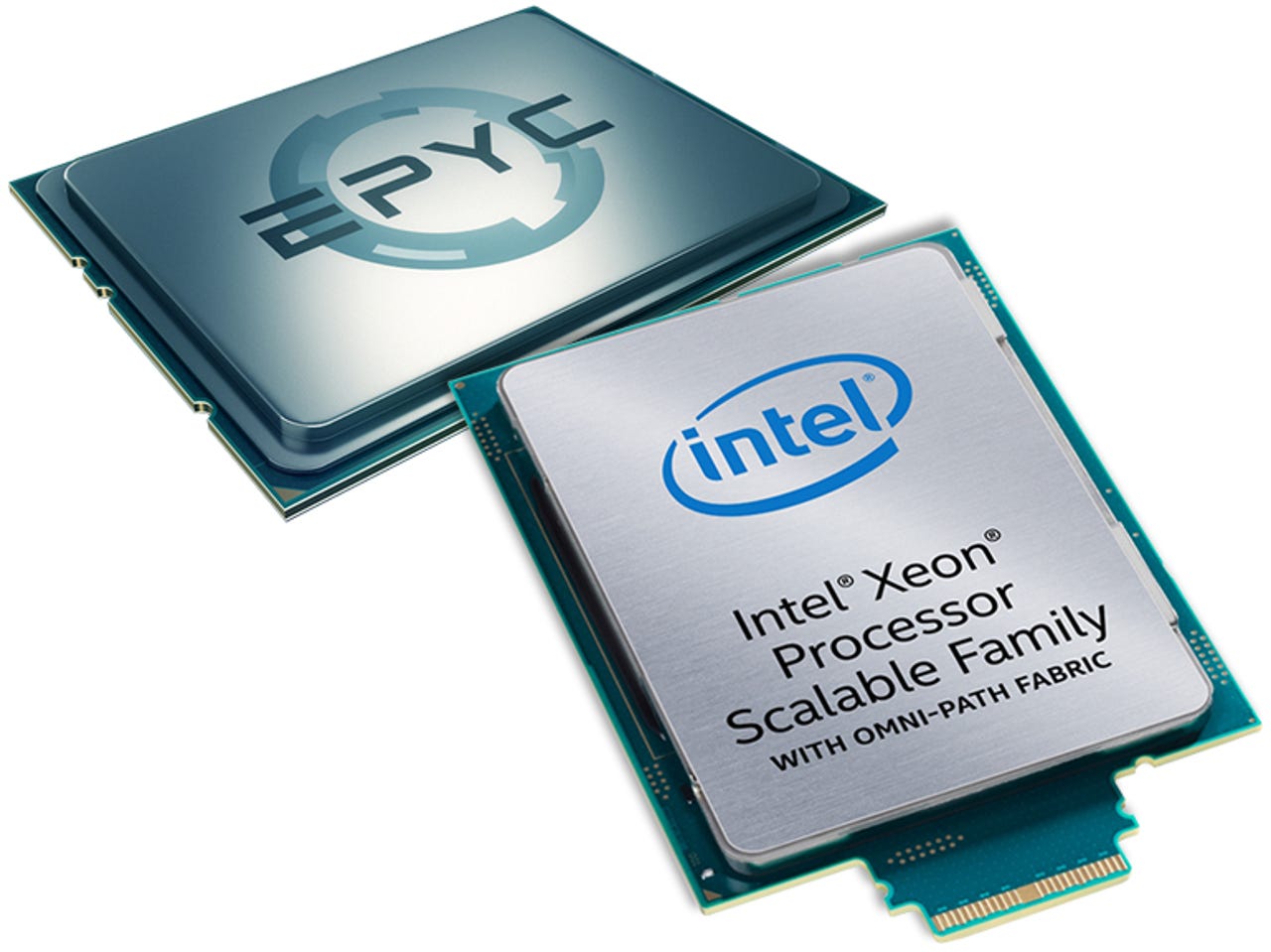A tale of two server processors: Intel Xeon Skylake-SP and AMD EPYC 7000 Series


Once a scarce and costly resource, computing power is fast becoming a commodity item with most of us carrying more in our pockets than we can use, and businesses able to get what they need, on-demand, from the public cloud.
OK, that's not completely true: the on-premises data centre is far from dead and most businesses still invest heavily in high-end server and processor technology. But here, too, the ready availability of compute power is having an effect. This was demonstrated by what happened next -- or rather didn't -- following the Skylake refresh of Intel's market-leading Xeon processor lineup earlier this year.
Not business as usual
Tech Pro Research
The way these things have always worked in the past is for Intel to announce a new processor or an intermediate refresh and for vendors to simultaneously launch servers based on the new technology. And, to begin with, that was what appeared to be happening when Intel released its Skylake Xeons, with all the big names pledging support accompanied by the usual rush of press reports and analyst opinion fleshing out the benefits and probable markets.
But then came a new twist, with AMD choosing to re-enter the server market for the first time in a decade with its EPYC 7000 Series processors. Moreover, AMD made the announcement just prior to the Skylake launch, leading to an understandable flurry of media speculation as to how they might compare and what effect it might have on the market.
But that was back in July and, although both processors have since been fully released, servers based on Skylake Xeons have taken ages to appear, while EPYC-based alternatives have been even slower out of the blocks.
Boston Fenway 2144-0T (Intel)
There have been exceptions, not least OEM vendor Supermicro, which broke ranks to deliver motherboards for both processors at launch. This allowed ZDNet to get a look at servers built around the new silicon, courtesy of European distributor Boston Limited, who invited us into their labs to see how they measured up.
We were able to get up close and personal with two of the new servers, starting with Boston's Intel-based Fenway 2144-0T equipped with two Skylake processors -- now officially the Xeon Scalable Processor family. Those in the review system were Xeon Gold 6132 processors (14 cores/28 threads) although the motherboard can accommodate any variant up to the maximum 28 cores/56 threads per socket supported by the Intel design.
Skylake Xeons require a new socket and chipset.
The new chips are necessarily large, requiring a new socket design and a new chipset (C621) to give access to 48 PCI-E lanes plus 24 DIMM slots that can be configured with up to 3TB of ECC DDR4 RAM. The memory is also accessed across 6 memory channels delivering 1.5 times the bandwidth of servers using previous Xeon E5 processors. In addition, the Skylake processors also benefit from support for the latest 512-bit Advanced Vector Extension (AVX-512) instruction set -- something that's not available on the AMD alternatives.
The Boston Fenway 2144-0T features dual Skylake Xeons with up to 28 cores per socket and 3TB of DDR4 RAM.
It's also worth noting that power and cooling requirements are increased compared to the previous generation of Xeons. The 6132 chips in the server we looked at, for example, draw 140 watts each rising to 205W on the top-of-the-range Skylakes. On the plus side, the Fenway 2144-0T has power and cooling to handle this, but in high-density racks airflow could be an issue.
Boston Fenway 2264-0T (AMD)
The AMD server we looked at was a Fenway 2264-0T, a 2U system with, again, two large sockets, this time for EPYC 7000 Series processors. Based on the same Zen technology as the desktop Ryzen processors, these are made up of four silicon dies per processor with up to eight cores per die, or 32 in total -- four more than with Intel's Skylake. Each core can run one or two hardware threads, but there's no chipset as the EPYC is effectively a System on a Chip (SoC) implementation with the necessary additional logic built into the processor package itself.
The socket for the AMD EPYC clearly shows connectors for the four constituent processor dies.
The smallest EPYC processor (the EPYC 7251) has just eight cores, although our review system had the range-topping 7601 variant with the full 32 cores (64 threads) per socket.
The Boston Fenway 2264-0T holds dual AMD EPYC 7000 Series processors with up to 32 cores per socket and 4TB of DDR4 RAM.
As well as extra cores, the AMD processors can access a lot more memory than those from Intel. To this end the Fenway 2264-0T has 32 DIMM slots available for up to 4TB of DDR4 RAM with eight memory channels per socket. The EPYC architecture also features support for 128 PCI-E lanes per socket, although 64 of these are used to communicate with the other processor so there are still only 128 altogether on the dual-socket server.
The AMD processors also tend to have lower TDP requirements compared to the Intel chips, topping out at 180W per socket at the high end.
The same but different
So, with Supermicro and Boston it seems like business as usual following the new processor launches. However, when it comes to the big guns of the enterprise server market -- Dell EMC and HPE -- it's a different story. Despite their initial pledges of support, Skylake servers were not readily available from either vendor on the day of the Intel launch, and are only just starting to make their way into customers' hands. Moreover, products based on AMD EPYC were, until recently, absent altogether from the big-name lineups.
The Proliant DL385 Gen10 is the first EPYC-based server from HPE.
That remains the case for Dell EMC, but while this article was in preparation HPE finally launched an EPYC product in the form of the Proliant DL385 Gen10. Expected to ship before the end of the year (some six months after the AMD launch), this server replaces the previous AMD Opteron product with a specification remarkably similar to to that of the Boston Fenway 2264-0T.
Despite that announcement, stories of AMD looking to take server market share from Intel have not been realised. None of the vendors are marketing the technologies head to head or positioning the different processors based purely on performance. In fact, the compute capability on offer is largely taken for granted and is being played down as vendors look for other ways of positioning their products in a market where compute is no longer a scarce resource.
Boston and HPE, for example, both see the high core count of the EPYC as a shoe-in for companies looking to consolidate large numbers of servers through virtualisation. HPE is also making a big play on the security front for all its servers, particularly the DL385 Gen10, leveraging the memory and VM encryption capabilities available on the AMD EPYC processors.
If nothing else, the way in which the new Intel and AMD processors have been assimilated shows that vendors realise that the server market is becoming more complex. Compute power is becoming a commodity resource and is increasingly available via the cloud, so enterprise customers won't automatically upgrade to the latest silicon or switch processor vendor without good reason. Server vendors will clearly need to work harder if they are to stay ahead of the game.
Related coverage
IEDM 2017: AMD says Epyc is just the beginning
AMD CEO Lisa Su capped a big year for the company with an opening address at IEDM 2017 where she predicted that a new approach to chip design will deliver another decade of big performance gains.
Intel renews data center push with launch of Xeon Scalable processors
Intel says the processors have up to 1.65 times higher performance power than its previous generation of chips.